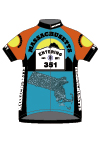In April 2022, Mike traced the march route of Civil War General William T. Sherman, using the effort to raise more than $30 thousand for cancer research at Dana-Farber as a supplement to his regular Pan-Mass Challenge (PMC) fundraising. Donations, large and small, are welcomed and can be made via this link.
Mike's route took him from Chattanooga, TN through Atlanta finishing in Savannah, GA. Eight days and 600+ miles on the road -- filled with history and exploration.
History lesson: After capturing Atlanta, Sherman faced a decision -- what next? The Rebel army he had chased out of Atlanta turned north, threatening Tennessee and his supply line. Grant thought his proper course was to continue to press that army. Sherman had a different plan -- abandon his supply line back to Tennessee, and instead push forward 300 miles across Georgia to reconnect with Union supply at the port city of Savannah.
Grant was skeptical, but Sherman persisted, and Grant ultimately agreed. Sherman picked his healthiest 50,000 men, divided them into 4 marching columns, and directed them to march a steady pace of 15 miles a day. The columns picked two rendezvous points en route, but otherwise were directed to fan out and ensure the countryside was unable to further supply the Rebel cause. Sherman's General Order instructed the troops to "forage liberally on the country during the march" and his men fully embraced the spirit of that command. Each regiment sent out a foraging group each day ("bummers", as the natives called them) responsible for requisitioning supplies. Other troops would destroy any military targets -- factories, and especially railroads. The technique: use the ties to build a bonfire, use the fire to heat the rails, then wrap the rails around trees, creating "Sherman neckties". The combined army had a front 50 miles wide, every day marching forward 15 miles stripping the land. It served its purpose -- demoralize the Georgia population, while providing everything the army required to supply itself.
My first objective today was Stone Mountain, the most popular park in Georgia. It's the largest exposed granite dome in the world, towering 800 feet above the surrounding countryside. Sherman rode by here. The KKK was reborn here. And -- it's the site of the largest Confederate monument ever created -- a 150' high carving of President Jefferson Davis, Robert E. Lee and Stonewall Jackson directly into the side of the mountain in the 60s and 70s, the height of segregation resistance. My photo on a grey, rainy morning doesn't do it justice. This one gives a better perspective. The park does animated laser shows, romanticizing the Lost Cause.
I stood in the parking lot staring up at the carving, processing. I thought, "What would Sherman do?" ("Load cannons, fire!"). My simile: if someone spray painted a swastika on a public building, it's an offensive, racist symbol, we would remove it, whatever it took. This is zero different. If we can carve something into the rock, we can carve something off of the rock. It will leave a scar. But the scar would also have meaning. Something parents could explain to their children. A scar is far better than the open wound on the rock today. And, while I applaud the creative idea of adding Sherman to the mountain, the right doesn't undo the wrong.
I hit the Uncle Remus Museum first. It was, shall we say, very "old school". I was the only visitor and had a long chat with the woman behind the counter. She told me they sold a lot of bootleg "Song of the South" DVDs for $25. And had a wide range of visitors from all over the world. My conclusion -- I'm not in favor of cancelling Uncle Remus. The stories aren't about romanticizing plantation life (although they do that), and while they might appropriate black culture, they do so in a way that give credit to it. Brer Rabbit is a metaphor for the black slaves -- always at risk, but always in the end able to outwit Brer Fox (the white man).
I went on to the B&B to meet my host Karen. I had expected this kind of Karen. Instead -- Karen was wearing a John Lewis T-shirt. She and her husband Richard are a mixed race couple, emigrated from the UK to Boston as adults, and then relocated to Georgia several years ago. I had a long, frank conversation with her. She ran last year for City Council on a platform that included removing Confederate symbols from town, the most prominent of which is a Confederate soldiers' monument in front of the courthouse. While Eatonton itself is majority black and has a black mayor, Putnam County is 71% white, and the power resides there. According to Karen, Eatonton's mayor refers to the white county sheriff as "Boss". And the sheriff took exception to Karen's candidacy. And -- she lost.
Karen described Eatonton as a warm and friendly community to her and her family. But, the blacks know they need to be very careful with the sheriff's department. And, the county power brokers do not welcome dissent. I deeply enjoyed Karen and Richard's hospitality, and highly recommend their B&B if your travels take you to Eatonton.
I'll close on a lighter note. On my way to Stone Mountain, I enjoyed breakfast at the very first Waffle House (a Georgia and Southland institution). It was in a black neighborhood, but I felt completely at home. I went back to my bike after breakfast and two black men struck up a conversation with me -- they were blown away with what I was doing, especially at my age. We talked for several minutes -- just three people talking, sharing stories and learning about each other. The way things should be!

